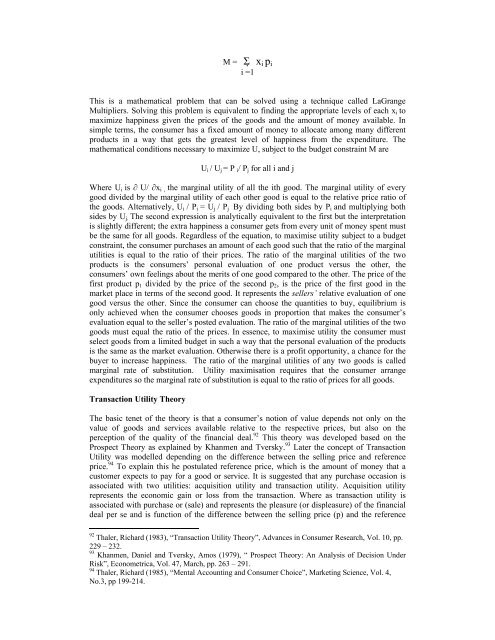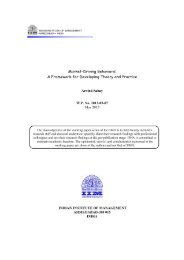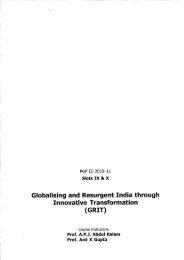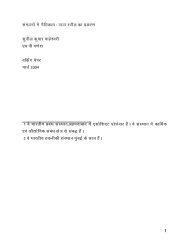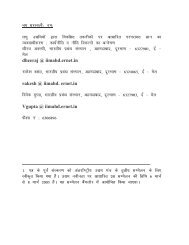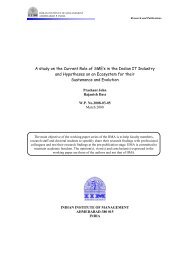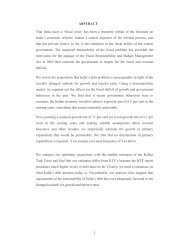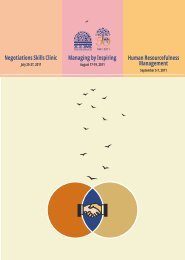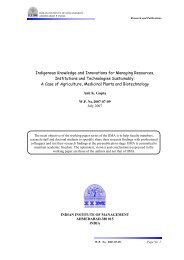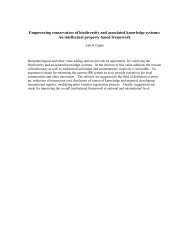The retail format is the store - Indian Institute of Management ...
The retail format is the store - Indian Institute of Management ...
The retail format is the store - Indian Institute of Management ...
You also want an ePaper? Increase the reach of your titles
YUMPU automatically turns print PDFs into web optimized ePapers that Google loves.
M = Σ xi pi<br />
i =1<br />
Th<strong>is</strong> <strong>is</strong> a ma<strong>the</strong>matical problem that can be solved using a technique called LaGrange<br />
Multipliers. Solving th<strong>is</strong> problem <strong>is</strong> equivalent to finding <strong>the</strong> appropriate levels <strong>of</strong> each xi to<br />
maximize happiness given <strong>the</strong> prices <strong>of</strong> <strong>the</strong> goods and <strong>the</strong> amount <strong>of</strong> money available. In<br />
simple terms, <strong>the</strong> consumer has a fixed amount <strong>of</strong> money to allocate among many different<br />
products in a way that gets <strong>the</strong> greatest level <strong>of</strong> happiness from <strong>the</strong> expenditure. <strong>The</strong><br />
ma<strong>the</strong>matical conditions necessary to maximize U, subject to <strong>the</strong> budget constraint M are<br />
Ui / Uj = P i/ Pj for all i and j<br />
Where Ui <strong>is</strong> ∂ U/ ∂xi , <strong>the</strong> marginal utility <strong>of</strong> all <strong>the</strong> ith good. <strong>The</strong> marginal utility <strong>of</strong> every<br />
good divided by <strong>the</strong> marginal utility <strong>of</strong> each o<strong>the</strong>r good <strong>is</strong> equal to <strong>the</strong> relative price ratio <strong>of</strong><br />
<strong>the</strong> goods. Alternatively, Ui / Pi = Uj / Pj By dividing both sides by Pi and multiplying both<br />
sides by Uj. <strong>The</strong> second expression <strong>is</strong> analytically equivalent to <strong>the</strong> first but <strong>the</strong> interpretation<br />
<strong>is</strong> slightly different; <strong>the</strong> extra happiness a consumer gets from every unit <strong>of</strong> money spent must<br />
be <strong>the</strong> same for all goods. Regardless <strong>of</strong> <strong>the</strong> equation, to maxim<strong>is</strong>e utility subject to a budget<br />
constraint, <strong>the</strong> consumer purchases an amount <strong>of</strong> each good such that <strong>the</strong> ratio <strong>of</strong> <strong>the</strong> marginal<br />
utilities <strong>is</strong> equal to <strong>the</strong> ratio <strong>of</strong> <strong>the</strong>ir prices. <strong>The</strong> ratio <strong>of</strong> <strong>the</strong> marginal utilities <strong>of</strong> <strong>the</strong> two<br />
products <strong>is</strong> <strong>the</strong> consumers’ personal evaluation <strong>of</strong> one product versus <strong>the</strong> o<strong>the</strong>r, <strong>the</strong><br />
consumers’ own feelings about <strong>the</strong> merits <strong>of</strong> one good compared to <strong>the</strong> o<strong>the</strong>r. <strong>The</strong> price <strong>of</strong> <strong>the</strong><br />
first product p1 divided by <strong>the</strong> price <strong>of</strong> <strong>the</strong> second p2, <strong>is</strong> <strong>the</strong> price <strong>of</strong> <strong>the</strong> first good in <strong>the</strong><br />
market place in terms <strong>of</strong> <strong>the</strong> second good. It represents <strong>the</strong> sellers’ relative evaluation <strong>of</strong> one<br />
good versus <strong>the</strong> o<strong>the</strong>r. Since <strong>the</strong> consumer can choose <strong>the</strong> quantities to buy, equilibrium <strong>is</strong><br />
only achieved when <strong>the</strong> consumer chooses goods in proportion that makes <strong>the</strong> consumer’s<br />
evaluation equal to <strong>the</strong> seller’s posted evaluation. <strong>The</strong> ratio <strong>of</strong> <strong>the</strong> marginal utilities <strong>of</strong> <strong>the</strong> two<br />
goods must equal <strong>the</strong> ratio <strong>of</strong> <strong>the</strong> prices. In essence, to maxim<strong>is</strong>e utility <strong>the</strong> consumer must<br />
select goods from a limited budget in such a way that <strong>the</strong> personal evaluation <strong>of</strong> <strong>the</strong> products<br />
<strong>is</strong> <strong>the</strong> same as <strong>the</strong> market evaluation. O<strong>the</strong>rw<strong>is</strong>e <strong>the</strong>re <strong>is</strong> a pr<strong>of</strong>it opportunity, a chance for <strong>the</strong><br />
buyer to increase happiness. <strong>The</strong> ratio <strong>of</strong> <strong>the</strong> marginal utilities <strong>of</strong> any two goods <strong>is</strong> called<br />
marginal rate <strong>of</strong> substitution. Utility maxim<strong>is</strong>ation requires that <strong>the</strong> consumer arrange<br />
expenditures so <strong>the</strong> marginal rate <strong>of</strong> substitution <strong>is</strong> equal to <strong>the</strong> ratio <strong>of</strong> prices for all goods.<br />
Transaction Utility <strong>The</strong>ory<br />
<strong>The</strong> basic tenet <strong>of</strong> <strong>the</strong> <strong>the</strong>ory <strong>is</strong> that a consumer’s notion <strong>of</strong> value depends not only on <strong>the</strong><br />
value <strong>of</strong> goods and services available relative to <strong>the</strong> respective prices, but also on <strong>the</strong><br />
perception <strong>of</strong> <strong>the</strong> quality <strong>of</strong> <strong>the</strong> financial deal. 92 Th<strong>is</strong> <strong>the</strong>ory was developed based on <strong>the</strong><br />
Prospect <strong>The</strong>ory as explained by Khanmen and Tversky. 93 Later <strong>the</strong> concept <strong>of</strong> Transaction<br />
Utility was modelled depending on <strong>the</strong> difference between <strong>the</strong> selling price and reference<br />
price. 94 To explain th<strong>is</strong> he postulated reference price, which <strong>is</strong> <strong>the</strong> amount <strong>of</strong> money that a<br />
customer expects to pay for a good or service. It <strong>is</strong> suggested that any purchase occasion <strong>is</strong><br />
associated with two utilities: acqu<strong>is</strong>ition utility and transaction utility. Acqu<strong>is</strong>ition utility<br />
represents <strong>the</strong> economic gain or loss from <strong>the</strong> transaction. Where as transaction utility <strong>is</strong><br />
associated with purchase or (sale) and represents <strong>the</strong> pleasure (or d<strong>is</strong>pleasure) <strong>of</strong> <strong>the</strong> financial<br />
deal per se and <strong>is</strong> function <strong>of</strong> <strong>the</strong> difference between <strong>the</strong> selling price (p) and <strong>the</strong> reference<br />
92<br />
Thaler, Richard (1983), “Transaction Utility <strong>The</strong>ory”, Advances in Consumer Research, Vol. 10, pp.<br />
229 – 232.<br />
93<br />
Khanmen, Daniel and Tversky, Amos (1979), “ Prospect <strong>The</strong>ory: An Analys<strong>is</strong> <strong>of</strong> Dec<strong>is</strong>ion Under<br />
R<strong>is</strong>k”, Econometrica, Vol. 47, March, pp. 263 – 291.<br />
94<br />
Thaler, Richard (1985), “Mental Accounting and Consumer Choice”, Marketing Science, Vol. 4,<br />
No.3, pp 199-214.


